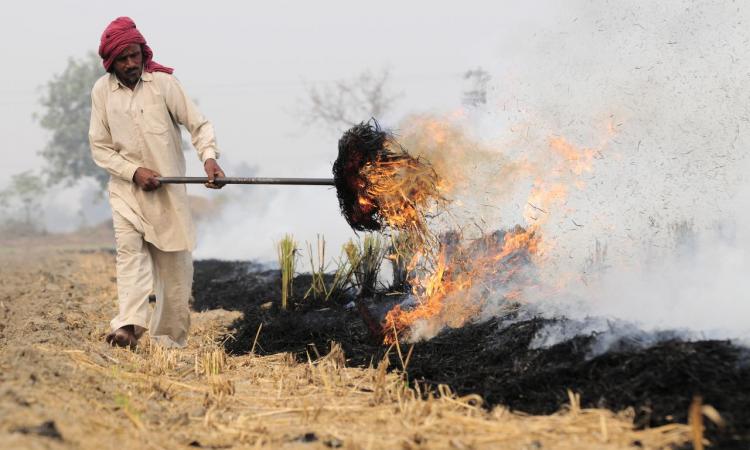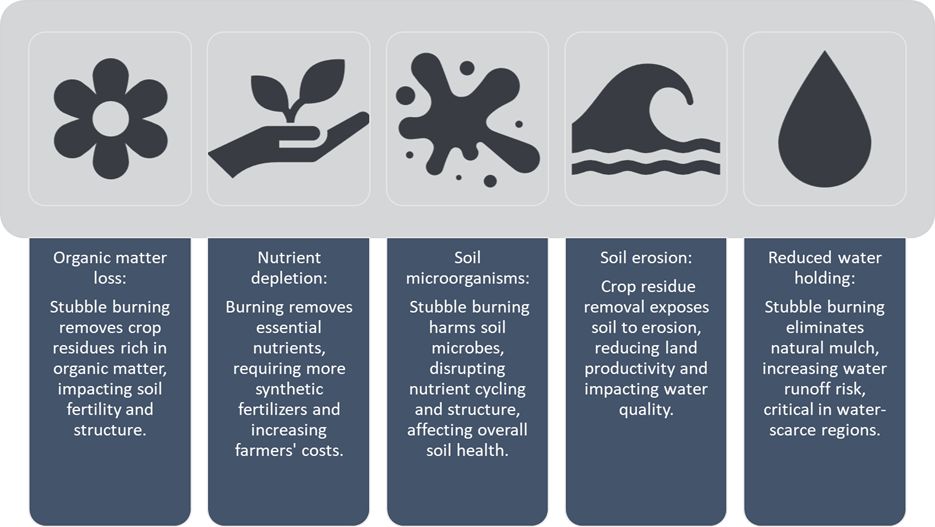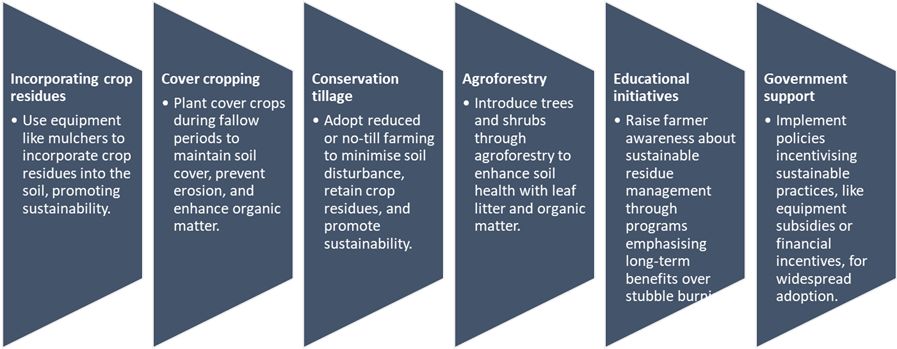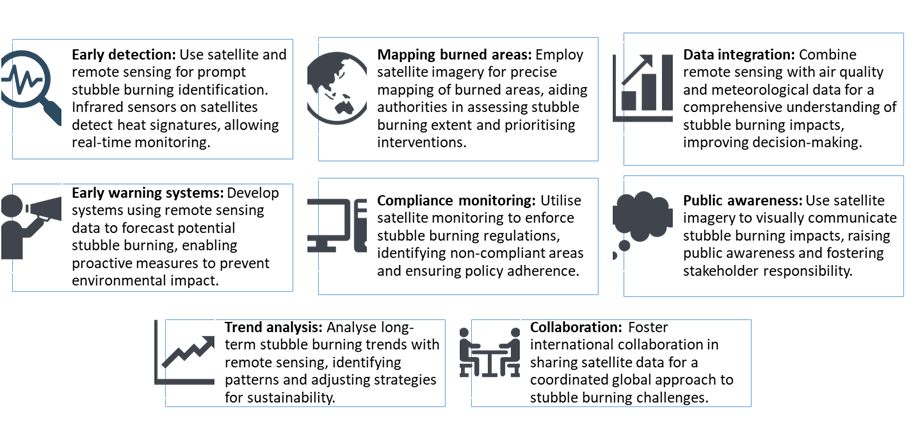
Every winter, in the bustling city of Delhi and its neighbouring areas, a thick layer of smog settles and the air there is heavy with pollution - the consequence of a widespread agricultural practice known as stubble burning. As the farmers in the neighbouring states prepare their fields for the next planting season in this predominantly rice-wheat belt, the remnants of their previous harvest (mostly rice) are set ablaze. The smoke, laden with particulate matter and noxious gases, wafts into the atmosphere having a significant impact on residents of Delhi.
Schools are forced to close, and outdoor activities come to a halt as the air quality index soars to hazardous levels. A collective cough echoes through the crowded streets, and faces vanish behind masks as people attempt to shield themselves from the toxic air. Visibility dwindles, casting a surreal haze over landmarks like India Gate. State governments armed with satellite data and real-time air quality monitoring, blame each other instead of collaborating to enforce regulations to discourage the age-old tradition of stubble burning.
This set of FAQs deals with the various facets related to stubble burning in north India.
What are the primary reasons behind the widespread practice of stubble burning in agricultural regions of India?
Stubble burning, the practice of setting fire to crop residues after harvesting, allowing farmers to prepare their land for the next sowing season without investing in costly machinery or labour is a widespread practice in agricultural regions of India, particularly in the northern states of Punjab, Haryana, and Uttar Pradesh.
Furthermore, the prevalent use of mechanised farming practices, including combine harvesters, leaves behind significant amounts of crop residue, mainly in the form of stubble. The lack of economically viable and efficient residue management technologies exacerbates the dependence on burning as a quick and accessible solution.
Agricultural policies and support mechanisms also play a role in perpetuating stubble burning. Subsidies and incentives for certain crops may encourage farmers to focus on those crops, leading to concentrated periods of residue burning during specific agricultural seasons.
The widespread practice of stubble burning in India arises from a complex interplay of economic pressures, technological limitations, and systemic factors. Addressing this issue effectively requires a multifaceted approach that combines technological innovation, policy adjustments, and comprehensive education and awareness programs for farmers.

How does stubble burning contribute to air pollution, and what are its potential health implications for both rural and urban populations?
Stubble burning significantly contributes to air pollution, releasing a plethora of harmful pollutants into the atmosphere. The combustion of crop residues emits large quantities of particulate matter (PM), including PM2.5 and PM10, which can penetrate deep into the respiratory system. These fine particles can exacerbate respiratory conditions such as asthma and chronic obstructive pulmonary disease (COPD) and are linked to an increased risk of cardiovascular diseases.
Moreover, stubble burning releases various gases and chemicals, including carbon monoxide (CO), nitrogen oxides (NOx), sulfur dioxide (SO2), and volatile organic compounds (VOCs). These pollutants can react in the atmosphere to form secondary pollutants like ozone and contribute to the formation of smog. Prolonged exposure to these air pollutants has adverse health effects, particularly for vulnerable populations such as children, the elderly, and individuals with pre-existing respiratory or cardiovascular conditions.
The health implications are not limited to rural areas where burning occurs; the impact extends to urban populations as well. Prevailing wind patterns can carry the pollutants over long distances, affecting air quality in urban centers. This transboundary transport of pollutants from agricultural regions to urban areas intensifies the overall air pollution levels, leading to increased respiratory and cardiovascular health risks for urban residents.
In rural settings, where stubble burning is more common, the health implications are compounded by direct exposure to the emissions. Farming communities, including farmers and their families, are at a higher risk of respiratory issues and other health problems due to their proximity to burning fields. Additionally, the pollutants released during stubble burning can settle on crops and water sources, potentially contaminating the food and water supply, further jeopardising the health of rural populations.
Addressing the health implications of stubble burning necessitates comprehensive measures, including the promotion of alternative agricultural practices, the development of sustainable residue management technologies, and awareness campaigns to mitigate the impact on both rural and urban communities.
What technological alternatives or innovations exist to address the issue of stubble burning and promote sustainable agricultural practices?
Various technological innovations provide alternatives to address stubble burning, promoting sustainable agricultural practices. Modern machinery, including mulchers and straw balers, efficiently incorporates crop residues into the soil, eliminating the need for burning and enhancing soil fertility. Crop diversification and conservation agriculture practices, such as introducing cover crops and minimizing soil disturbance, contribute to reducing residues and improving overall soil health, preventing erosion, and promoting sustainable farming.
Bioenergy technologies, like biomass gasification and bioethanol production, offer eco-friendly solutions by converting crop residues into valuable energy resources, benefiting rural communities and mitigating environmental impact. Remote sensing and precision agriculture technologies, utilising satellite imagery and sensor-based data, assist farmers in monitoring crop conditions, predicting yields, and implementing precise harvesting techniques to optimise practices and reduce residue generation. Government policies incentivising the adoption of these technologies, along with financial support and awareness programs, encourage farmers to invest in modern equipment and practices that eliminate stubble burning. A collaborative effort involving farmers, policymakers, and researchers is crucial for successfully integrating these innovations into agricultural systems, fostering a transition towards sustainable and environmentally friendly farming practices.

How effective have government policies been in curbing stubble burning, and what challenges are hindering their successful implementation?
Government efforts to curb stubble burning in India encounter varying degrees of effectiveness, facing challenges in implementation. Some states offer financial incentives and subsidies to encourage farmers in adopting alternative residue management technologies, aiming to make sustainable practices economically attractive. Awareness campaigns educate farmers on the environmental and health impacts of stubble burning, promoting sustainable agriculture.
However, challenges persist, notably the economic burden on farmers. The high costs associated with advanced residue management machinery pose financial challenges, particularly for small landholders, incentivising some to continue stubble burning for its cost-effectiveness. Inconsistent enforcement and monitoring add complexity, with the dispersed nature of agriculture making it challenging to regulate burning practices across vast regions.
Seasonal time constraints exacerbate the issue, leaving farmers with a narrow window for adopting alternatives. To address these challenges, a comprehensive approach is essential. Financial support must align with socio-economic factors influencing farmers, coupled with research and development investments to make alternative technologies more accessible. Streamlined monitoring systems and ongoing stakeholder engagement are crucial for the effective and sustainable implementation of policies aimed at mitigating the environmental impact of agricultural practices.
How does stubble burning affect soil health and long-term agricultural sustainability, and what measures can be taken to mitigate these effects?
Stubble burning has significant implications for soil health and long-term agricultural sustainability. The practice affects the soil in several ways, and mitigating these effects requires the adoption of alternative agricultural practices. Here's an overview of the impact and potential measures:

Mitigating the adverse effects of stubble burning involves the adoption of alternative agricultural practices:

Consideration of viable economic alternatives to stubble burning includes investing in mechanised stubble management through machinery like the Happy Seeder or Super Seeder, which can incorporate stubble back into the soil, thereby enhancing fertility and reducing dependency on burning. Additionally, the establishment of biogas plants offers a sustainable solution by converting stubble into clean energy, providing farmers with extra income and lessening reliance on fossil fuels.
Furthermore, initiatives such as creating a market for stubble as raw material for bio-industries or animal bedding, present economic incentives for farmers to avoid burning. Moreover, government subsidies, can play a crucial role in supporting farmers by providing financial assistance for purchasing machinery or setting up biogas plants, thereby facilitating the transition away from burning. By implementing these measures, farmers can mitigate the negative effects of stubble burning, improve soil health, and contribute to the long-term sustainability of agriculture.
What role do advancements in technology, such as remote sensing and satellite monitoring, play in tracking and managing stubble burning incidents, and how can they be integrated into broader environmental management strategies?
Advancements in technology, particularly remote sensing and satellite monitoring, play a crucial role in tracking and managing stubble burning incidents, contributing to more effective environmental management strategies. Here's how these technologies are utilised and integrated:

Integrating these technological advancements into broader environmental management strategies requires interdisciplinary collaboration, policy support, and stakeholder engagement. Governments, environmental agencies, research institutions, and technology developers can work together to establish robust monitoring systems, develop actionable insights from the data, and implement targeted interventions to reduce the environmental impact of stubble burning. The integration of technology into environmental management strategies contributes to a more data-driven and effective approach to address complex environmental challenges.
/articles/faq-stubble-burning-india-causes-effects-and-solutions